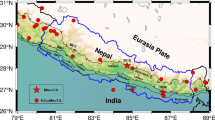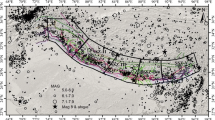Abstract
Statistical studies on earthquake recurrence time probabilities have frequently been applied to seismic hazard analyses. In Taiwan, an instrumental catalog provides a good opportunity to examine statistical attributes of earthquakes around the study region, with the objective to evaluate the seismic risk and earthquake potential for hazard mitigation. With the completeness of recordings, seismic rates for small-to-moderate magnitudes can be obtained. An elimination of aftershocks was performed using a double-link cluster analysis method. The time intervals between a series of events (the inter-occurrence periods) are stationary with an identical temporal distribution. Based on the goodness-of-fit testing between a few models and observation, we suggested the use of the Gamma distribution in modeling this variable, earthquake inter-occurrence periods, for the study region. Accordingly, unified relationship was constructed, and statistical limitations of sparse sampling for devastating earthquakes (such as M ≥ 6.0 or 7.0) could be resolved. The empirical result evaluated by introducing the conditional probability indicates that the recurrence probability of a M ≥ 7.0 earthquake is 78.8 % within 10 years in Taiwan region.









Similar content being viewed by others
References
Bak P, Tang C (1989) Earthquakes as a self-organized critical phenomenon. J Geophys Res 94(B11):15635–15637
Bak P, Christensen K, Danon L, Scanlon T (2002) Unified scaling law for earthquakes. Phys Rev Lett 88(178501):1–4
Chakravarti IM, Laha RG, Roy J (1967) Handbook of methods of applied statistics, vol 1. Wiley, Volume I, pp 392–394
Cheng SN, Wang TB, Lin TW, Jiang CH (2010) Establishment of Taiwan earthquake catalog, vol 54. Seismology Technical Report of Central Weather Bureau, pp 575–605
Corral Á (2004) Long-term clustering, scaling, and universality in the temporal occurrence of earthquakes. Phys Rev Lett 92:108501
Corral Á (2006) Dependence of earthquake recurrence times and independence of magnitudes on seismicity history. Tectonophys 424:177–193
Davis SD, Frohlich C (1991) Single-link cluster analysis of earthquake aftershocks: decay laws and regional variations. J Geophys Res 96:6336–6350
Dieterich JH (1994) A constitutive law for rate of earthquake production and its application to earthquake clustering. J Geophys Res 99(B2):2601–2618
Field EH (2007) Overview of the working group for the development of regional earthquake likelihood models (RELM). Seismol Res Lett 78(1):7–16
Gutenberg B, Richter CF (1944) Frequency of earthquakes in California. Bull Seismol Soc Am 34:185–188
Hagiwara Y (1974) Probability of earthquake occurrence as obtained from Weibull distribution analysis of crustal strain. Tectonophys 23:313–318
Hasumi T, Akimoto T, Aizawa Y (2009a) The Weibull-log Weibull transition of the interoccurrence time statistics in the two-dimensional Burridge-Knopoff Earthquake model. Phys A 388:483–490
Hasumi T, Akimoto T, Aizawa Y (2009b) The Weibull-log Weibull distribution for interoccurrence times of earthquakes. Phys A 388:491–498
Hasumi T, Chen CC, Akimoto T, Aizawa Y (2010) The Weibull-log Weibull transition of interoccurrence time for synthetic and natural earthquakes. Tectonophys 485:9–16
Hsu MT (1961) Seismicity in Taiwan (Formosa). Bull Earthq Res Int Tokyo Univ 29:831–847
Jackson DD, Kagan YY (1999) Testable earthquake forecasts for 1999. Seismol Res Lett 70(4):393–403
Jacob KH (1984) Estimates of long-term probabilities for future great earthquakes in the Aleutians. Geophys Res Lett 11:295–298
Jordan TH (2006) Earthquake predictability, brick by brick. Seismol Res Lett 77(1):3–6
Kagan YY, Knopoff L (1981) Stochastic synthesis of earthquake catalogs. J Geophys Res 86:2853–2862
Kagan YY, Knopoff L (1987) Statistical short-term earthquake prediction. Science 236(4808):1563–1567
Knopoff L, Kagan Y, Knopoff R (1982) b-values for fore- and aftershocks in real and simulated earthquake sequences. Bull Seismol Soc Am 72:1663–1676
Lin CH (1996) Crustal structures estimated from arrival differences of the first P-waves in Taiwan. J Geol Soc China 39:1–12
Ogata Y (1988) Statistical models for earthquake occurrence and residual analysis for point processes. J Am Stat As 83:9–27
Pacheco JF, Scholz CH, Sykes LR (1992) Changes in frequency-size relationship from small to large earthquakes. Nature 355:71–73
Purcaru G (1975) A new magnitude-frequency relation for earthquakes and a classification of relation types. Geophys J R Astron Soc 42:61–79
Rhoades DA, Gerstenberger MC (2009) Mixture models for improved short-term earthquake forecasting. Bull Seismol Soc Am 99(2):636–646
Rikitake T (1974) Probability of an earthquake occurrence as estimated from crustal strain. Tectonophys 23:299–312
Saichev A, Sornette D (2006) Universal distribution of inter-earthquake times explained. Phys Rev Lett 97:078501
Savage JC (1992) The uncertainty in earthquake conditional probabilities. Geophys Res Lett 19:709–712
Schwartz DP, Coppersmith KJ (1984) Fault behavior and characteristic earthquakes-examples from the Wasatch and San Andreas fault zones. J Geophys Res 89:5681–5698
Shimazaki K, Nakata T (1980) Time-predictable recurrence model for large earthquakes. Geophys Res Lett 7:279–282
Snedecor GW, Cochran WG (1989) Statistical methods, 8th edn. Iowa State University Press, Iowa
Stephens MA (1974) EDF statistics for goodness of fit and some comparisons. J Am Stat As 69:730–737
Talbi A, Yamazaki F (2009) Sensitivity analysis of the parameters of earthquake recurrence time power law scaling. J Seismol 13(1):53–72
Ustaszewski K, Wu YM, Suppe J, Huang HH, Chang CH, Carena S (2012) Crust-mantle boundaries in the Taiwan–Luzon arc-continent collision system determined from local earthquake tomography and 1D models: Implications for the mode of subduction polarity reversal. Tectonophysics. doi:10.1016/j.tecto.2011.12.029 (in press)
Utsu T (1972) Large earthquakes near Hokkaido and the expectancy of the occurrence of a large earthquake of Nemuro. Rep Coord Comm Earthq Predict 7:7–13
Utsu T (1974) A three-parameter formula for magnitude distribution of earthquake. J Phys Earth 22:71–85
Utsu T, Ogata Y, Matsuura S (1995) The centenary of the Omori formula for a decay law of aftershock activity. J Phys Earth 43:1–33
Wang JH (1989) The Taiwan telemetered seismographic network. Phys Earth Planet Inter 58:9–18
Wang CY, Shin TC (1998) Illustrating 100 years of Taiwan Seismicity. Terr Atmos Ocean Sci 9:589–614
Wang JP, Chan CH, Wu YM (2011) The distribution of annual maximum earthquake magnitude around Taiwan and its application in the estimation of catastrophic earthquake recurrence probability. Nat Hazard. doi:10.1007/s11069-011-9776-x
Wiemer S (2001) A software package to analyse seismicity: ZMAP. Seismol Res Lett 72:373–382
Wiemer S, Wyss M (2000) Minimum magnitude of completeness in earthquake catalogs: examples from Alaska, the Western United States, and Japan. Bull Seismol Soc Am 90(4):859–869
Wu YM, Chen CC (2007) Seismic reversal pattern for the 1999 Chi–Chi, Taiwan, Mw7.6 earthquake. Tectonophys 429:125–132
Wu YM, Chiao LY (2006) Seismic quiescence before the 1999 Chi–Chi, Taiwan Mw7.6 earthquake. Bull Seismol Soc Am 96:321–327
Wu YM, Chen CC, Zhao L, Chang CH (2008a) Seismicity characteristics before the 2003 Chengkung, Taiwan, earthquake. Tectonophys 457:177–182
Wu YM, Chang CH, Zhao L, Teng TL, Nakamura M (2008b) A comprehensive relocation of earthquakes in Taiwan from 1991 to 2005. Bull Seismol Soc Am 98:1471–1481
Yeh YH, Tsai YB (1981) Crustal structures of central Taiwan from inversion of P-wave arrival times. Bull Inst Earth Sci 1:83–102
Acknowledgments
We thank Paul Wessel and Walter Smith for developing and supporting the GMT mapping tools. This work was supported by Central Geological Survey, Central Weather Bureau, and the National Science Council, Taiwan. We thank Prof. Thomas Glade and two anonymous reviewers for their constructive comments.
Author information
Authors and Affiliations
Corresponding author
Rights and permissions
About this article
Cite this article
Chen, CH., Wang, JP., Wu, YM. et al. A study of earthquake inter-occurrence times distribution models in Taiwan. Nat Hazards 69, 1335–1350 (2013). https://doi.org/10.1007/s11069-012-0496-7
Received:
Accepted:
Published:
Issue Date:
DOI: https://doi.org/10.1007/s11069-012-0496-7




